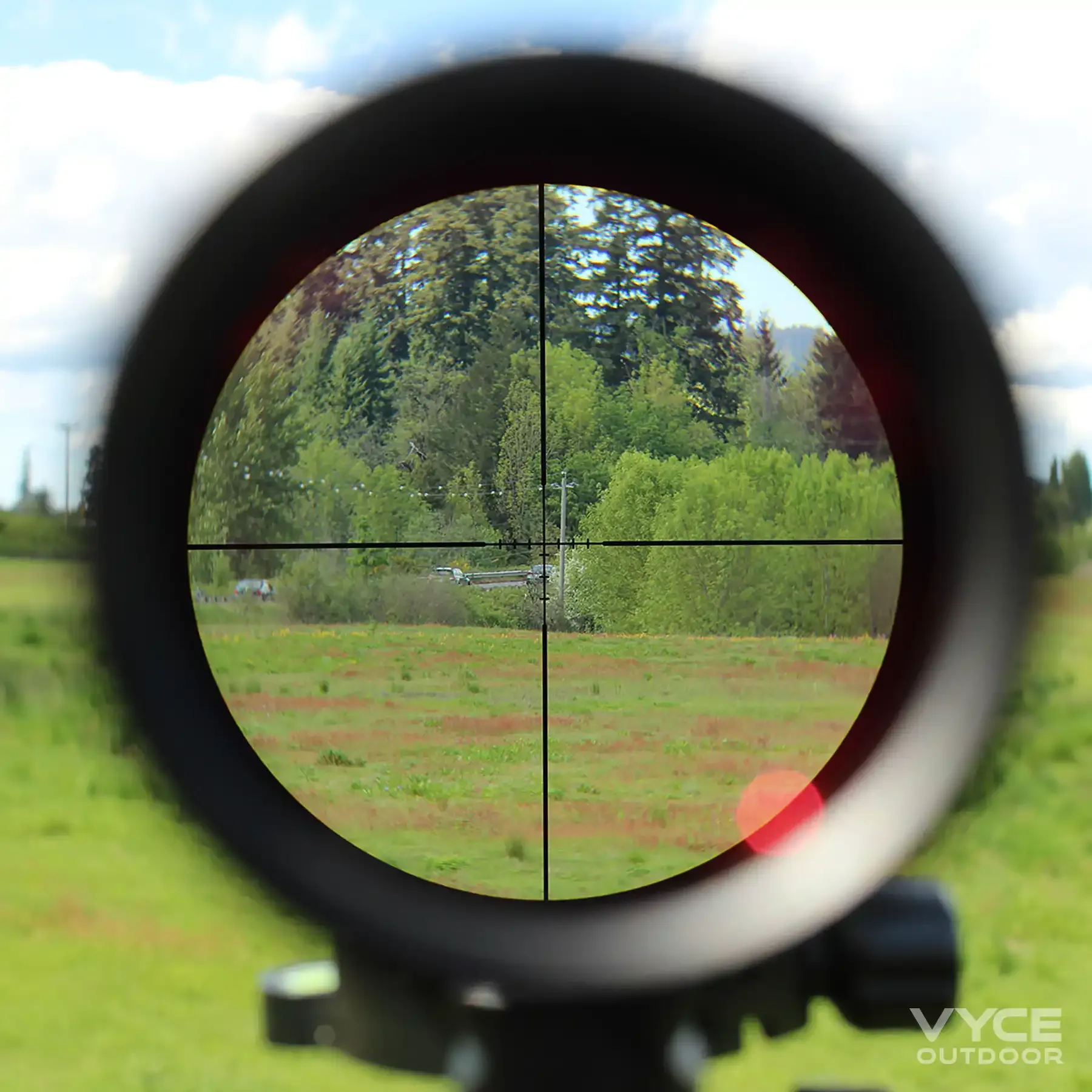2025 Review: Vortex Crossfire II - Which scope is best?
We review and compare Vortex Crossfire II scopes to decide which one is best, looking at glass clarity, reticle, and performance compared to other scopes on the market.

Our team independently reviews products and writes articles for the gun community. As an Amazon affiliate, some links in our stories may earn us a commission for qualified purchases.
- Last Updated May 2, 2025
The Vortex Crossfire II is an all-around awesome scope for the money. Impressive eye relief, wide field of view, and surprisingly clear glass for the price. There are a few higher-end features that are missing, but for this price, the Crossfire II series is tough to beat.

I got my hands on some of the most popular Crossfire II models: the 3-9x40, 4-12x44, 2-7x32, and 1-4x24 to do a thorough comparison and review of how these scopes perform and decide if they’re worth the money in 2025.
Summary
The Crossfire II is the perfect scope for hunting, tactical setups, and plinking within the $100 - $200 price range. After spending a few weeks testing 4-12x44 and 3-9x40, I was blown away by how clear the glass was for the price. Sure, there are a few small drawbacks with some of the models (which I’ll cover below), but Vortex offers different features and reticle combinations in the Crossfire II for just about any setup.

If I was going to choose any one of these scopes to purchase for the first time, I would get the 3-9x40 or the 4-12x44, most importantly, I’d make sure to get the models with the V-Plex reticle. The V-Plex reticle offers a slimmer crosshair in the center, allowing you to squeeze some extra precision out of the scope. The 3-9x40 and 4-12x44 both offer a solid magnification range and a better eye box than the 2-7x32 or 1-4x24.

I would only opt for the 2-7x or the 1-4x Crossfire II if you are trying to create a lightweight rifle setup where size and weight are more important than scope magnification. If you are planning to use the lower 2x or 1x magnification levels more than the higher magnification settings, these are also a better choice.
We’ll cover which model is best for each setup at the end, but overall, the Crossfire II offers impressive performance at the best price possible.
Best Crossfire II Scopes
Best Overall
 Crossfire II 4-12x44 - V-Plex Reticle
Crossfire II 4-12x44 - V-Plex ReticleBest balance of magnification and eye relief overall with impressive clarity.
Best Mid Range
 Crossfire II 3-9x40 - V-Plex Reticle
Crossfire II 3-9x40 - V-Plex ReticleLower magnification for mid range, with better eye relief and field of view.
Best for Long-Range Precision
 Crossfire II 6-18x44 AO - V-Plex Reticle
Crossfire II 6-18x44 AO - V-Plex ReticleBest precision option with affordable parallax adjustment and wide magnification range.
Our Testing & Review
For this review, I tested the different Crossfire II scopes on a number of different rifles, namely a 22 LR, my 17 HMR, and also an AR-15 chambered in .223/5.56.
On my AR-15, I tested the 1-4x24, 2-7x32, and 3-9x40 Crossfire II models to see how they handled from 50 yards out to 400 yards.

On the rimfire rifles, I tested the 3-9x40 and 4-12x44, trying to nail smaller, varmint-sized targets between 50 - 250 yards.
In both cases, I was mainly assessing the clarity of the glass, reticle, eye relief and eye box to see if these scopes were bright enough and clear enough to hit targets of all sizes with good precision.


Crossfire II 4x (left) vs 10x (right) - cars at 900 yards
Overall, I preferred the 3-9x40 and the 4-12x44 the most—the eye box on these scopes were the most forgiving, allowing me to shoot at a bench, standing, and lying prone with solid precision.
Reticle: Dead-Hold BDC, V-Plex, or V-Brite?
One of the most important things I found when testing these scopes is that the reticle choice matters:
The Dead-Hold BDC reticle has thicker crosshairs, making it a better choice for speed over precision. I’d opt for the Dead-Hold BDC reticle for shooting larger targets or deer within 200 yards, or if your eyes have trouble with finer crosshairs.

Crossfire II Dead Hold BDC reticle
My preferred reticle in the Crossfire II series is the V-Plex reticle—the outside posts are thicker, while the center is very fine. The fine crosshairs make the V-Plex reticle better for precision shooting at all distances, regardless of the target size.

For anyone hunting or shooting in low light environments, the Crossfire II series has models with reticle illumination (these are the V-brite illuminated scopes). These models cost a little bit extra, but the fine crosshairs and illuminated red center dot is the best of both worlds. The crosshairs are thinner like the V-Plex, with a center dot that lights up. If you don’t mind paying a little extra, the Crossfire II 3-9x50 V-Brite is probably the best scope in this lineup.
Glass: Clarity, Eye Relief, and Eye Box
Of all the things that surprised me most, the glass clarity, quality, and brightness was far beyond what I expected on the Crossfire II series for the price.
I own a Vortex Viper, Diamondback, and Strike Eagle—the Crossfire II’s clarity comes up a little short compared to the Diamondback which is the next step up. The clarity differences only become noticeable when you push beyond 250 yards, with the Crossfire II being a little less crisp than the Diamondback. Within 250 yards though, it is hard to tell the difference.

Left to right: Vortex Viper, Diamondback Tactical, Crossfire II, and Strike Eagle
If you plan on shooting at targets smaller than a deer beyond 400 yards, you’ll want to consider stepping up to the Vortex Diamondback for a more crisp sight picture. Anything below that, the Crossfire II is more than capable.

If you are looking at scopes with higher magnification, the eye box on the crossfire is plenty forgiving, especially on the 4-12x44, 3-9x40, and best on the 3-9x50. Eye relief is also generous, coming in around 4 inches.
On the lower magnification models like the 2-7x32 and 1-4x24, the eye box is a bit more sensitive when magnification is turned all the way up, but the 1x and 2x are solid. I’d recommend these if you plan on using the 1x and 2x most.
Controls: Turrets & Parallax
The beauty of the Crossfire II is the controls are dead simple. Windage and elevation knobs are capped, so most people will set their zero and forget about making adjustments on the fly.

If you’re looking for an ultra-affordable precision scope, the Crossfire II also has AO (Adjustable Objective) models with parallax adjustment. Parallax adjustment is really only necessary if you are trying to take extremely precise shots at long distances, in which case you might want to consider Vortex’s Diamondback Tactical (although these are nearly double the price).

AO models offer parallax adjustment near the front lens
For an affordable entry point into precision shooting, the Crossfire II 6-18x44 AO with the V-Brite reticle is a solid option thanks to its wide magnification range, Adjustable Objective (AO), larger 44mm objective lens, and precision-oriented reticle with illumination.
Construction: Durability & Finish
The finish on the Crossfire II is identical to almost all of the other offerings from Vortex. All Crossfire II’s offer a strong durable coating that holds up well against scratches. Looking at the scope’s exterior, you wouldn’t be able to tell the difference from any other Vortex model.
Drawbacks: What is it missing?
I think the largest drawback in the Crossfire II series is the glass clarity at extended ranges. Pushing out beyond 250 - 400 yards, the glass loses some of its “crispness” and the sight picture becomes a bit blurrier than higher end offerings from Vortex.

Crossfire II at 10x - car at 900 yards
For the price, though? Incredibly impressive. I would not hesitate to get a Crossfire II if I was looking for an affordable rifle scope or if I was putting together a more budget-friendly rifle setup.
Higher-end offerings from Vortex like the Diamondback or Diamondback Tactical offer exposed turrets and parallax adjustment via a side focus rather than adjustable objective (AO). If you plan on doing more precision or competition shooting, it may be worthwhile to save or eventually upgrade to the Vortex Diamondback.

Pros & Cons
Pros
Impressive clarity
Reliably holds zero
Great durability and finish
Cons
Not all models have parallax adjustment
Dead Hold BDC reticle is less precise
Which Crossfire II model is right for you?
3-9x40, 4-12x44, 3-9x50: Top Picks
The Crossfire II 3-9x40, 4-12x44, and 3-9x50 are all well-rounded and affordable scopes with solid magnification ranges. From this list, the 4-12x44 and the 3-9x50 are my favorites, both offering a better eye box and decent clarity for the price.
If you’re looking for a scope with moderate magnification and good performance at lower magnification levels (3x and 4x), these are my top picks. Any of these scopes would perform well for tactical setups or deer hunting within 400 yards. These would also work great for smaller targets (varmint and predator hunting) within 250 yards. Just be sure to get the V-Plex or V-Brite reticle if you’re looking for extra precision.
2-7x32, 1-4x24: Tactical & Speed Setups
If you’re looking for a lightweight rifle scope that performs best at 1x or 2x, the 2-7x32 or the 1-4x24 are the best options from the Crossfire II series.
Performance at the lower magnification levels is optimized here, with more forgiving eye boxes than the higher magnification scopes. If you need to prioritize fast shots at close distances from different (possibly uncomfortable) shooting positions, the Crossfire II 2-7x32 and 1-4x24 are solid options.
Crossfire II AO Scopes: Affordable Precision
Although the Adjustable Objective (AO) is more difficult to adjust than Vortex scopes with a side focus (like the Diamondback Tactical), the Crossfire II AO scopes offer an affordable entry point into long range precision shooting.
The adjustable objective requires you to look at the top of the scope and spin the cap near the front lens of the optic to eliminate and adjust parallax. Setting the parallax to the correct distance helps focus the scope and eliminate missed shots from imperfect head placement behind the scope.
The Crossfire II has a handful of AO models:
- 6-18x44 AO
- 4-12x40 AO
- 4-12x50 AO
- 4-16x50 AO
- 6-24x50 AO
These models offer higher magnification ranges, catering to long range precision shooting, hunting, and competition shooters.
Final Thoughts
With LPVO options for fast shooting, AO models for long range and precision shooting, and wide range of models and magnification ranges, the Crossfire II series has something for everyone. Overall, the Crossfire II series is an ultra affordable entry point into lightweight rifle scopes with great performance, and I'd highly recommend them to anyone looking for a decent scope on a budget.

Written by Alec S.
Author & FounderI'm Alec, founder and author of VYCE Outdoor! As a gun enthusiast and lover of the outdoors, I wanted to share my passion for firearms with other people and provide an unbiased source of original gun content, reviews, and news. I'm a CCW permit holder and enjoy shooting pistols and rifles with friends and family for home-defense, sport, and hunting.
 Crossfire II 2-7x32
Crossfire II 2-7x32